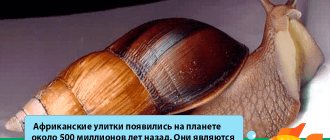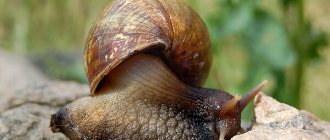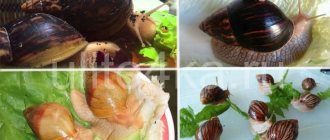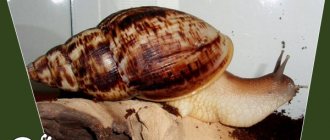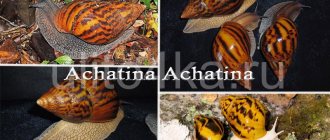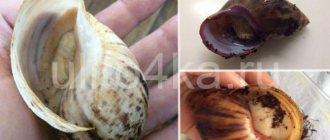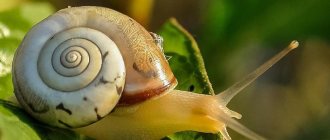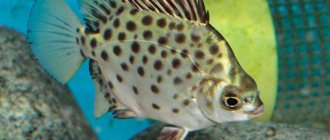A few facts about the snail that you need to know before buying it
- Achatina live 10 years, but in captivity they often live up to 6-7 years;
- Snails can reach 25 cm in length;
- Land mollusks are hermaphrodites, they have female and male genital organs;
- Achatina is very prolific. The number of eggs in a clutch can reach 500 pieces;
- Mollusks are deaf and have poor eyesight;
- Under unfavorable conditions they hibernate;
- Achatina are vegetarians. They need calcium to build a beautiful, large shell.
Achatina albino as a pet
Snails are ideal pets for almost everyone. First of all, they are unusual animals. Secondly, snails are omnivorous and unpretentious in food and care. Thirdly, these are exotic pets.
Achatina albinos have no smell, do not make a sound, do not bite or scratch, and do not need to be walked or played with on a daily basis. Also, people are not allergic to them, so they are used in cosmetology - snail therapy.
Two-horned pets are perfect as pets for busy people and children, as they require a little of your attention and time. Mollusks have one vulnerable spot - the shell. If it is seriously damaged, the mollusk most often dies.
History of aquarium distribution
Giant snails were first discovered in East Africa, from where they rapidly spread to the south of the continent and Madagascar. Ten years later, Achatina appeared in India, Sri Lanka, China and Malaysia.
In Japan, snail farms began to be created, where mollusks were bred to produce and sell large quantities of Achatina meat.
Due to the great damage that these snails caused - these pests devour garden crops, useful plants, almost everything in their path - in southern Asia people began to actively exterminate these creatures. And in new habitats the problem sometimes takes on even greater proportions. Thus, in the American state of Florida, the damage from these mollusks is so great that importing Achatina into the region is punishable by a prison sentence.
It would be wrong to talk only about the harm that these mollusks cause. They are also orderlies of their kind, destroying rotting and harmful plants, dying trees, animal excrement, and other waste.
In their homeland, Achatina, unlike other places, has a dangerous enemy that regulates the number of snails - the predatory mollusk Gonaxis, so in East Africa there is no question of fighting this pest; the balance is maintained naturally. But in new habitat regions, other dangers to the species have appeared, for example, mice, hedgehogs, moles, birds, and some insects.
In the harsh Russian climatic conditions, the spread of this gastro mollusk in the wild is impossible.
But in addition to harmful and beneficial properties, Achatina has an attractive appearance and their behavior is interesting to observe, so at the end of the 20th century they already began to occupy the niche of aquarium household inhabitants. They are kept as quiet pets that do not cause trouble and do not require special attention.
Snail selection
There are a great many species and varieties of Achatina snails. Achatina differ from each other: in size, color and pattern on the shell.
Almost all types of African snails are albino in color.
Most often at home they contain:
Achatina Fulica is the most common type of snail and comes in many different shell and body colors. Grows up to 20 cm in length. Unpretentious and very sociable.
Achatina achatina, grows up to 25 cm in length. In terrariums they are not found as often as fulica. They are more demanding of temperature and humidity, and are also reluctant to reproduce at home.
See more similar articles:
How to choose an aquarium for keeping the Achatina snail:...
Terrarium for the Achatina snail - rules and examples...
Back Forward 1 of 16
Achatina albinos grow very intensively up to a year. Then their growth slows down or stops completely.
If you choose an albino snail, be prepared to buy it at a pet store or from trusted breeders. Be sure to ask her parents, look at their photographs. This will guarantee that the offspring of your snail will also be albinos. It wouldn’t hurt to ask what kind of soil the snail was kept on and what its favorite food was. Read how to grow a big snail here.
Subspecies
Since the diversity of gastropod species has not been sufficiently studied, completely different information can be found in different sources. We will try to list the species of Achatina fulica, some of which live remarkably well in domestic conditions, while others are known only from shells from museums and about which practically nothing is known.
- Achatina fulica fulica;
- Achatina fulica var. hamillei;
- Achatina fulica var. hamillei f. rodatzi;
- Achatina fulica var. hamillei f. rodatzi albino body;
- Achatina fulica var. "White Jades";
- Achatina fulica castanea;
- Achatina fulica coloba;
- Achatina fulica sinistrosa;
- Achatina fulica umbilicata;
- Achatina fulica rufensis.
Achatina fulica fulica, Achatina fulica var. hamillei and Achatina fulica var. "White Jades" can most often be found in private collections.
Achatina fulica fulica (Achatina fulica standard)
The color of the shell can be varied. Mostly dark brown or black stripes on a yellow or white background, uniform brown or reddish brown. The columella can vary from white to bluish white. Body color can also vary from light brown to brown-black.
Achatina fulica var. hamillei (Achatina fulica hemeli)
Hemeli differs from standard Fulika in the color of its apex. Fulica Hemeli has a pink apex. In addition, the color of the shell may be more variegated. Columella white.
Achatina fulica var. hamillei f. Rodatzi (Achatina fulica rodatia)
These snails have a light albino yellow shell, which creates an impressive contrast with the dark body of the mollusk.
Achatina fulica var. hamillei f. rodatzi albino body
Rodatia albino body is a completely albino form with a light shell and white body color. Representatives of the albino body subspecies have yellow legs with age, which is associated with the presence of the pheomelanin pigment.
Achatina fulica var. "White Jades" (White Jade)
This subspecies has a standard shell color, but mostly with a more distinct striped pattern. The base color is yellowish, the stripes are reddish-brown to mahogany. The body is completely white. Columella is also white.
Terrarium for an albino snail
A plastic or glass container with a ventilated lid is an ideal housing for Achatina. An old aquarium or plastic food container will also work. The container size must be at least 20 liters. If you have not one, but several snails, then you need a lot of space for them to live. They don't like close quarters. Give preference to low and wide terrariums. Don't forget to ventilate the terrarium and place a thermometer and hygrometer. Read more about arranging a terrarium.
A glass terrarium heats up quickly, but also cools down quickly.
Heating in the terrarium
During the cold season, the terrarium needs to be heated. Most albinos do well at a room temperature of 22-25 degrees, but if your snail becomes lethargic and does not eat well, you need to increase the temperature in the terrarium. They need warmth and humidity to live comfortably. To heat the terrarium, use a thermal mat or a regular light bulb. If the soil is dry, spray it 1-2 times a day.
Achatina in a food container
Cohabitation of different species
Different types of Achatina snails can coexist in one aquarium. But the editors of axatina.ru recommend that you familiarize yourself with the table of their coexistence, because some species of Achatina cannot coexist together. The table shows only the most popular types of Achatina snails. We did not find information about the coexistence of other Achatina species.
Please rate this article:
Primer or substrate for the snail
Achatina needs a humid climate and soil. They like to dig and burrow into the soil to rest and lay eggs.
Soil for an albino snail should not contain pesticides, salts, fertilizers, plant products, or peat. You can buy a good substrate at a pet store or prepare it yourself.
Coconut substrate, which is coconut fiber, is considered the most common type of soil. It holds moisture well and does not stain the walls of the terrarium.
Sphagnum moss is also a good substrate, which is often used as an independent or combined soil for snails. Moss retains moisture well, does not stain the terrarium and serves as additional food for Achatina.
The soil is changed once a month, completely or partially.
The soil should always be moist, but do not make it muddy or swampy. Spray water in the terrarium daily and monitor the behavior of your animals. If the shellfish are sitting on the wall or lid of the container, then moisten it every two days. Stones, sand and sawdust are not suitable for snails as soil. They dry quickly and scratch the shell and body of the mollusk.
Reproduction
Puberty in Fulikas can occur quite early - at about 4-6 months they can begin the process of reproduction. But, most often, puberty does not depend on the age of this mollusk, but on the specific size of its shell. Therefore, if your young snails have grown their houses to 7-9 cm, then get ready for quick offspring, and if they are not desirable, place your pets.
During mating, cross-fertilization occurs and after some time both partners lay eggs in the ground, almost to the very bottom of the terrarium. This species is quite prolific - on average, one clutch can contain 100-300 eggs, and sometimes more. And Fulika can lay clutches up to six times a year.
Eggs of Achatina Fulica are white or yellowish in color, 4-5 mm in diameter.
The incubation period depends on the ambient temperature and averages 10-15 days. But snails can “carry” eggs and then the snails will appear earlier. And if the clutch is not full-term, then the incubation period increases accordingly.
The average survival rate is 90%. Therefore, do not neglect the advice of more experienced snail breeders and freeze the clutches.
Decorating a terrarium for a snail
The snail's home can be decorated with natural and artificial accessories. Interesting twisty driftwood and branches, cork bark or artificial aquarium plants. You can decorate an aquarium with Achatina with live plants or sow seeds of mustard, wheat, oats, be prepared that over time they will be eaten.
Be creative when decorating your snail's home. Avoid stones in the terrarium, as if a snail falls on them from a height, the consequences can be fatal.
You can stick a poster on the back of your terrarium with different images on it, such as plants, cities, mountains, cartoon characters.
Plastic flower pots (clean and empty) make an excellent hiding place for your snail to nap and rest during the day. Avoid using those made of ceramic or stone.
Feeding and water
Feed the snail 1-2 times a day with fresh vegetables and fruits. Always wash them before giving them to your Achatina.
The clam should always have calcium. Edible chalk, sepia, eggshell, shell rock.
All these products can be purchased at any pet store or online. Snails need them for shell growth and proper development. Recipes for nutritional supplements for rapid snail growth.
Vegetables and fruits
- Lettuce leaves
- Broccoli
- Cauliflower
- Tomato
- Carrot
- Apple
- Pears
- Clover leaves
- Pumpkin seeds
- Raisin
- Turnip
- Peas
- Mushrooms
- Cucumber
- Celery
- Strawberry
- Watermelon
- Banana
- Raspberries
- Zucchini
- bell pepper
- Sweet corn
Water for Achatina
Place a plastic bowl of clean drinking water in the terrarium. Snails will not only drink from it, but also swim. Monitor the purity of the water and the depth in the container. Read about the importance of water for snails here.
Foods your snail shouldn't eat
Onions, pasta, anything with salt or sugar. Spicy and smoked.
Nutrition
In nature, Achatina prefer plant foods, but in general they are not picky about food. They can eat rotting parts of plants, excrement and other impurities, sometimes even rotting trees.
The African snail is a nocturnal animal, so it prefers to feed at night. Achatina’s diet should include a variety of, but only natural, foods: vegetables, herbs, fruits, meat, boiled eggs, oatmeal, chalk, eggshells. You need to be careful with bananas and cucumbers; it may happen that, after trying these products once, the snail will refuse other food. Shellfish eat a lot, and in the absence of food they can fall into a somnambulistic state.
To form a shell, Achatina requires calcium, so in addition to eggshells, you can give limestone, medical chalk, and calcium gluconate.
How to pick up a snail
You can take your pet when the snail grows up and is not scary to hold in the palm of your hand. Try to handle babies less often to avoid damaging them. Before handling Achatina, wash your hands thoroughly with warm, clean water or wear latex gloves. The palm or glove should be damp.
Never pick up a snail by its shell, as you may pull it out completely, damaging the internal organs of the mollusk. Crush or damage the fragile walls of the Achatina shell. Try to take the snail from the ground, gently and carefully place your finger under it, when the snail moves onto your palm, hold it with your other hand.
The older Achatina gets, the less fear she will have of communicating with you. They are friendly and curious pets. If your children help you care for snails, warn them to handle these exotic mollusks with care and attention. And don’t forget to wash your hands with soap after interacting with the African snail.
Natural habitat of Achatina fulica
The natural habitat of the giant African land snail is located in Africa, which has a warm tropical climate with year-round high temperatures and high humidity. However, it is adapted and was able to thrive in temperate climates. This species prefers low to mid altitude areas, with a temperature preference between nine degrees Celsius and twenty-nine degrees Celsius. Achatina fulica can survive in less ideal conditions, for example, at two degrees Celsius they hibernate. Achatina can live in agricultural lands, coastal areas, swampy areas, forests, and urban areas. However, they need temperatures above zero and, preferably, high humidity.
They have adapted to dry and cooler areas because they can wait out unfavorable weather conditions by hibernating.
Bathing or snail hygiene
Water procedures bring a lot of positive emotions to Achatina and their owners. You can gently wipe the strong shell and delicate body of the mollusk with a soft brush or sponge. To bathe snails, use clean boiled or filtered water, which is poured into a shallow container. Never keep your snail under a tap or in a deep bowl when their breathing hole becomes full - they will drown.
After bathing, gently dry the sink with a towel and lubricate it with natural vegetable oil (olive, pumpkin). If your terrarium has a drinking bowl with boiled water, make sure it is clean, as the snails will constantly “hang out” in it.
Never wash your snail with soap.
Snail cleaning
It is carried out once every 3-4 weeks, depending on the size of the terrarium and the number of snails living in it. Wash the terrarium, bowls and decor only in warm water, then pour boiling water over everything. Replace all or part of the substrate, branches and snags. Some substrates can be processed and reused, but are easier to replace.

